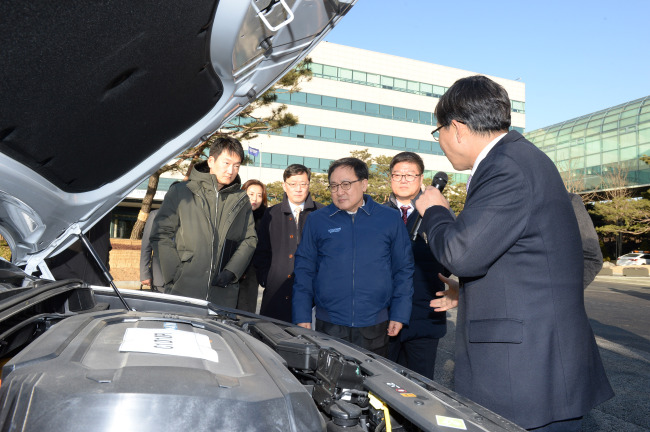Korea to provide more frequency bands for new industries, social infrastructure in 2018
Government unveils details of frequency supply plan for autonomous driving, IoT, smart factories, and 5G telecom network
By Song Su-hyunPublished : Dec. 28, 2017 - 15:59
In a move to make South Korea a more convenient and safe country, the government will increase the supply of frequency bands for emerging industries and households next year by easing related regulations, the Ministry of Science and ICT announced Thursday.
As part of the government’s plans for a 3 percent growth next year, the ICT Ministry unveiled its plan to provide frequency bands and set standards for new industries such as autonomous driving, wireless charging, Internet of Things and drone by 2020.
The plan includes a total of 14 new sectors for frequency supply and 25 deregulation cases for the next two years, expecting the measures to contribute to creating about 170,000 new jobs and 49 trillion won worth production inducement.
The ministry also announced its roadmap for commercialization of the fifth-generation telecommunications network, as well as launching the frequency auction in June 2018 and aiming to commercialize the network in March 2019. The target date of the auction is a year earlier than initially planned in order to be at the forefront of the global 5G competition, according to the announcement. The price for 5G frequency is estimated to be around 10 trillion won ($9.3 billion).
For the self-driving industry, the ministry will set a technological standard stipulating that the frequency band for sensors that prevent vehicle clashes should be 77 to 81 gigahertz (GHz).
As part of the government’s plans for a 3 percent growth next year, the ICT Ministry unveiled its plan to provide frequency bands and set standards for new industries such as autonomous driving, wireless charging, Internet of Things and drone by 2020.
The plan includes a total of 14 new sectors for frequency supply and 25 deregulation cases for the next two years, expecting the measures to contribute to creating about 170,000 new jobs and 49 trillion won worth production inducement.
The ministry also announced its roadmap for commercialization of the fifth-generation telecommunications network, as well as launching the frequency auction in June 2018 and aiming to commercialize the network in March 2019. The target date of the auction is a year earlier than initially planned in order to be at the forefront of the global 5G competition, according to the announcement. The price for 5G frequency is estimated to be around 10 trillion won ($9.3 billion).
For the self-driving industry, the ministry will set a technological standard stipulating that the frequency band for sensors that prevent vehicle clashes should be 77 to 81 gigahertz (GHz).

In order to realize fully-autonomous driving, the sensors, considered the “eye” of autonomous vehicles, would require technical elevations, and in doing so would need such frequency band standards, the ministry said.
The government will start providing frequency bands for wireless charging points for compact electric vehicles, making it possible to charge cars anywhere. Yet, the ministry will set the frequency standard in accordance with an upcoming agreement by the World Radiocommunication Conference in 2019.
For IoT, sufficiency of frequency sources are essential to the rapidly growing use of IoT sensors, the ministry said, as it came up with a plan to supply 5GHz-frequency spectrum in addition to the current 900 megahertz and 2.4GHz bands.
The ICT Ministry will also establish technological requirements for the frequency bands provided for flights of unmanned cargo aircraft for secure control and telecommunications. For smaller drones with special purposes such as preventing forest fires, the ministry will further come up with safety standards, it said.
Licensed IoT frequency channels will be provided for smart factories, allowing manufacturers to create a secure IoT network within their plants that help improve productivity and keep security.
Those factories will also be able to utilize the Long Term Evolution telecom network for operations in the unlicensed frequency bands, which will enable sending and receiving visual data from production sites to back offices, improving from the current voice-focused trunked radio system.
Additional frequency bands will be supplied for artificial intelligence robots used at smart factories in order to prevent clashes and telecommunications among the robots.
“Frequency for industries and daily lives is a crucial source of the ‘fourth industrial revolution,’” said Ryu Je-myung, director general of the frequency policy bureau at the ministry. “The government will continue policy efforts to provide frequency at an opportune time for appropriate use, which will help promote new industries and therefore improve quality of digital lives.”
In the field of social infrastructure, the government’s plan is focused on quality of life, the main mantra of the administration’s 2018 economic blueprint.
By providing the 2.3Ghz band that is available for building over 1Gbps backhauls that receive large-volume data from the internet network, citizens will be able to use about 100 times faster Wi-Fi at public places including the metro trains, the ministry said.
The 5.8GHz band will be applied to adjust streetlights with an aim to cut down power consumption by the lamps by 30 percent.
A plan for using 1GHz for the ground penetrating radar system purposed at preventing sink holes will also be discussed next year, which will be used more widely for management swage systems and constructions.
With the IoT frequency, individuals will also be able to charge their smartphones through IoT sensors without plugging the devices into power outlets.
By Song Su-hyun (song@heraldcorp.com)





![[From the Scene] Monks, Buddhists hail return of remains of Buddhas](http://res.heraldm.com/phpwas/restmb_idxmake.php?idx=644&simg=/content/image/2024/04/19/20240419050617_0.jpg&u=20240419175937)





![[Graphic News] French bulldog most popular breed in US, Maltese most popular in Korea](http://res.heraldm.com/phpwas/restmb_idxmake.php?idx=644&simg=/content/image/2024/04/18/20240418050864_0.gif&u=)


![[From the Scene] Monks, Buddhists hail return of remains of Buddhas](http://res.heraldm.com/phpwas/restmb_idxmake.php?idx=652&simg=/content/image/2024/04/19/20240419050617_0.jpg&u=20240419175937)

![[KH Explains] Hyundai's full hybrid edge to pay off amid slow transition to pure EVs](http://res.heraldm.com/phpwas/restmb_idxmake.php?idx=652&simg=/content/image/2024/04/18/20240418050645_0.jpg&u=20240419100350)

![[Today’s K-pop] Illit drops debut single remix](http://res.heraldm.com/phpwas/restmb_idxmake.php?idx=642&simg=/content/image/2024/04/19/20240419050612_0.jpg&u=)